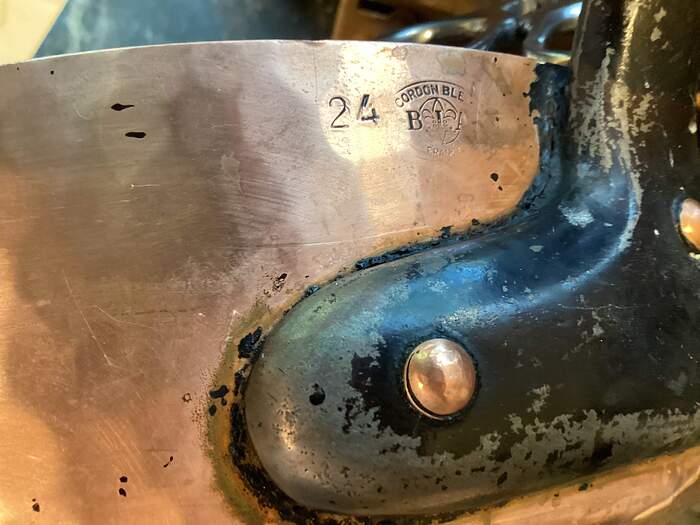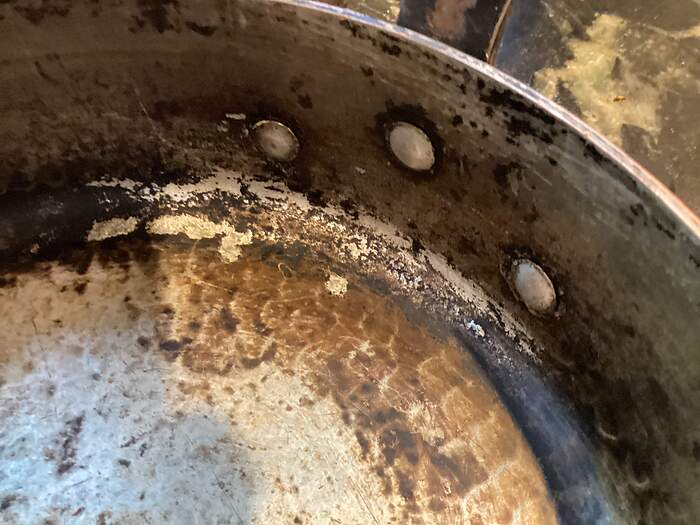Yes😢, cryingly expensive. But arguably among the best cookware ever made.
It is, by all accounts, as fine as anything being made today. Their style and details are impeccable. After 3/4 of a lifetime building out my own kitchen, these would look fancy enough to be out of place, and so I shall pass. I am grateful these were not available when I began.
I love copper but the tin scares me…I’m afraid that somehow I will screw it up and melt the tin.
A few years ago I invested in some Falk pieces, and I have been extremely happy with them as my daily drivers.
Why Brooklyn copper is better?
Oh yeah. I remember you prefer the stainless steel surface.
It is heavy and meticulously constructed, but so were many of the pans of old. The filet of sole can’t tell the difference. Heck, it probably couldn’t recognize Tramontina. On the other hand, Tramontina wouldn’t give you goosebumps without even having food in it.
Glad you love your Falk. I have a tinned sauté pan that has been in use about half a century without needing to be re-tinned. If you use wooden or silicone tools it is pretty easy to maintain. Tin and stainless cook quite differently, but the difference is easily masked with butter, oil, or some other fat.
Sure, this is a common fear. Common, that is, among people who don’t already own and use tinned copper. Unless you leave a pan empty over heat, it’s not very realistic.
In all the years I’ve constantly been using it (and maybe 60 pieces), I’ve had precisely ONE minor incident with bubbled/smeared tin. This was a vintage frypan that had been obviously and somewhat sloppily re-tinned. I suspect the newer tin was just applied over the remnants of the old. Even then, the pan didn’t require retinning.
Now, there are reasons not to prefer tin linings. If you (or others in your kitchen) can’t NOT: (a) scour; (b) cook using metal utensils; or (c) cut and serve foods in and from the pan with knives and metal tools, then maybe choose something else.
Falk is very good stuff. The issue for me with bimetal is that the max thickness is 2.3mm of copper. Reasonable minds can differ over whether thicker is preferable, but if you want thicker, tinned (or silvered) is the only choice. Thicker is my preference, and vintage tinned extra fort pans in good condition can often be had for far less money.
I view BCC as a choice for those who want–and can afford-- the best features of premier vintage pans in totally new condition. Over a lifetime of cooking, it’s not that expensive.
Well said Kaleo, and I do respect your judgement and comments. i think if we were to all look at our net investment in knives and cookware in here, we would be quite shocked. I think over the years my greatest financial investment in kitchen/cooking items would be my kitchen knives, and that I am not willing to confess in detail in this public venue or I would be pilloried. Let’s just say I like sharp things.
But did we not already say expensive cookware do not yield better cooking skill?
Wabi. Don’t want to derail the conversation… which is your most used/or most beloved kitchen knife?
To make you feel better, I also buy computer better than my gaming skill.
Chem, my most used knife in my kitchen is a Teruyasu Fujiwara Denka 180mm gyuto,. followed by a similar nakiri and a Takeda petty. Those are my standard dinner prep knives.
Those Denkas are really sweet blades💪
I’m not quite as careful as you about overheating. I think one of the most common misapprehensions about copper is that melting the tin means it needs retinning. It almost never does, certainly not if you melt it briefly while cooking so that it just bubbles or smears. The explanation I’ve seen for why is the tin that can be displaced past 450F is “excess” tin, like wipe marks, and the top layer of tin oxide/tarnish. But the rest of the tin under it can’t move because it’s bonded to the tin-copper intermetallic, whose melting point is much higher, close to aluminum’s.
So while melting tin can mess up the finish, it doesn’t cause much if any practical damage, except that the bubbling forms some high points that are vulnerable to wearing down (so some bits of excess tin will get lost prematurely).
A “sloppy” retinning job, or for that matter a thick tinning like factory Mauviel with the heavy wipe marks, is therefore more susceptible to noticeable damage from melting than a thin tinning without any drips or wipe marks. Not that this means you should prefer the thin tin of course, better to have excess that can be messed up than no buffer at all.
About retinning done over the remnants of the old tin, I’ve tinkered a bit and asked some pros, and there’s nothing wrong with that, as long as the purity of the old tin isn’t in doubt. It melts and incorporates smoothly into the fresh tin, damage and irregularities in the old tin don’t carry over at all. The issues that can occur with dark spots of poor tin adhesion in DIY or badly done retinning are when oxidation is left in the pan. I see this especially in areas that are harder to clean thoroughly, like in pitting, knife slashes, corners, around the rivets and near the rim.
Here in the middle clip you can see properly cleaned remnants of the last tinning that get tinned over in an A+ restoration (not so great pan though). I prefer to see this vs grinding out all the old tin, mainly because it guarantees no copper was removed by aggressive sanding/grinding, secondarily because it conserves more tin, a relatively scarce resource. https://www.instagram.com/p/CD9s4-hpIcn/?igsh=M2VkMjBmaXp1emVx
Hear! Hear! As I have shared several times, I have a 3mm saute pan that was returned because its new owner had bubbled it a bit. I bought it for half off and half a century later am still cooking on that same tin!
Wow, what a testimonial for what I assume is the Mauviel factory tinning? Does it still feel slick?
I wonder whether customer returns for bubbled or tarnished tin are a chief reason the old copper producers who offer bimetal lines seem to have zero interest in promoting their tinned ones.
The stamp says BIA. The pan is a workhorse. As you can see, the cooking surface is well seasoned. It is easy to use as a true sauté pan if you have a stout wrist.




